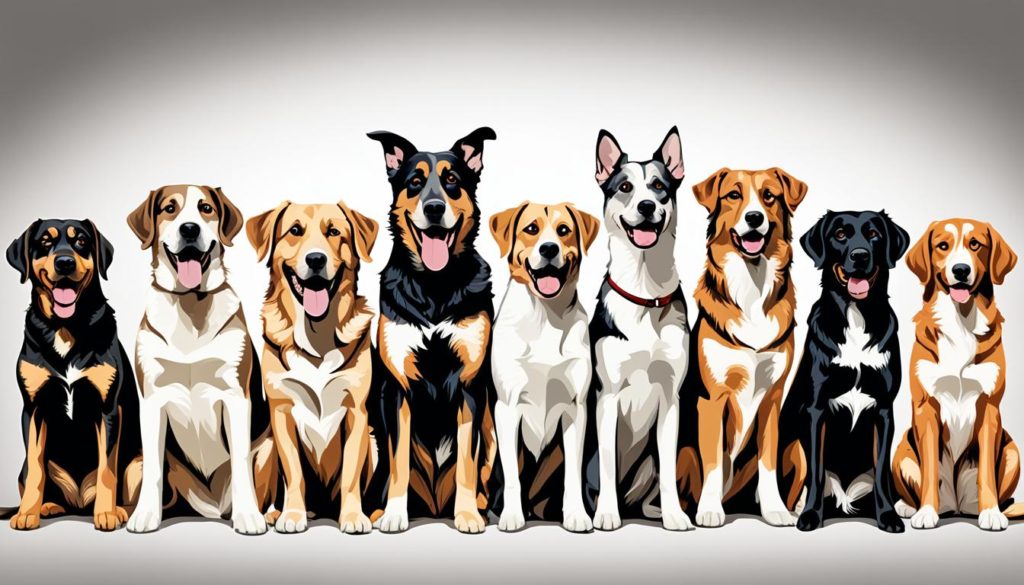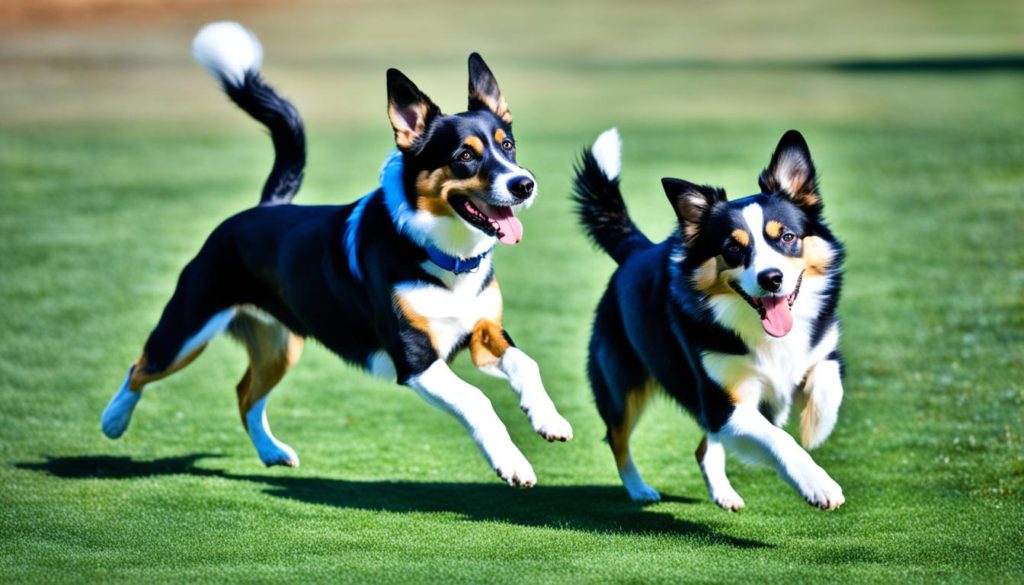When it comes to our furry friends, understanding their communication cues is essential for building a strong bond. One important aspect of canine communication is their tail wagging. While many pet owners interpret it as a sign of happiness, tail wagging can convey a variety of emotions and messages. To truly understand a dog’s state of mind, we need to decode the meaning behind their tail movements.
By paying attention to the position, speed, and direction of a dog’s tail wag, we can gain valuable insights into their communication signals. Is the tail held high or low? Is it wagging vigorously or gently? These subtle variations in tail movements can provide us with a deeper understanding of our canine companions.
Key Takeaways:
- Decoding a dog’s tail wagging can help us understand their emotions and intentions.
- The position, speed, and direction of the tail wag can provide valuable insights into a dog’s state of mind.
- Pay attention to subtle variations in tail movements to better understand a dog’s communication signals.
- Interpreting a dog’s tail wagging is crucial for building a strong bond and improving your relationship with your pet.
- Remember to approach your dog with empathy and respect while observing their tail wagging and other communication cues.
Understanding Body Language: Eyes, Ears, and Fur
A dog’s body language is a multifaceted form of communication that includes various components, such as eye contact, ear positions, and fur. By observing these cues, you can gain a deeper understanding of a dog’s emotions and intentions. For example, the position of a dog’s tail can indicate excitement or fear, while the appearance of their fur can signify alertness or relaxation. Paying attention to these subtle signals can help you interpret a dog’s body language more accurately.
When it comes to dog body language, the tail plays a significant role. A wagging tail doesn’t necessarily mean a happy dog. The position, movement, and speed of the tail can provide valuable insights into their state of mind. Let’s take a closer look at some common dog tail positions:
| Tail Position | Meaning |
|---|---|
| High and stiff | Alertness, aggression, or dominance |
| Horizontal and wagging | Friendliness, curiosity, or excitement |
| Tucked between hind legs | Fear, submission, or anxiety |
It’s important to observe other components of a dog’s body language alongside the tail position. For example, a dog with a high and stiff tail, bared teeth, and raised hackles may be displaying aggression. On the other hand, a dog with a horizontal tail, relaxed body posture, and open mouth may be expressing friendliness and invitation to play.
In addition to the tail, the eyes and ears can provide additional insights into a dog’s emotional state. Dilated pupils may indicate excitement or fear, while narrowed eyes can signify aggression. Similarly, erect ears can indicate alertness, while flattened ears may suggest fear or submission. The appearance of a dog’s fur can also provide valuable clues. Raised fur along the back, known as piloerection, may indicate heightened arousal or aggression, while smooth and relaxed fur suggests a calm and contented dog.
Interpreting a dog’s body language requires careful observation and an understanding of the context. Dogs rely on their body language to communicate their needs, emotions, and intentions, and by paying attention to their eyes, ears, fur, and tail movements, you can better understand and respond to their signals.
Vocalizations: Barks, Growls, and Whines
Dogs communicate not only through their body language but also through vocalizations. Barks, growls, and whines are all forms of dog vocalizations that have specific meanings. Understanding the tone, pitch, and duration of these vocalizations can provide insights into a dog’s emotional state.
For instance, a high-pitched bark accompanied by a loose wagging tail may indicate excitement, while a low growl can signify aggression or a warning. By interpreting a dog’s vocalizations in conjunction with their body language, we can better understand their communication signals and respond accordingly.
“A dog’s vocalizations are like words in their own language. Paying attention to the different sounds they make can offer valuable information about their feelings and intentions.”
To help you better understand dog vocalizations and their meanings, here are some common types:
| Type of Vocalization | Meaning |
|---|---|
| Bark | Can indicate excitement, fear, alertness, or a warning. |
| Growl | May signify aggression, dominance, fear, or a warning. |
| Whine | Often expresses discomfort, anxiety, or the desire for attention. |
It’s important to note that the context in which these vocalizations occur is crucial for accurate interpretation. A playful bark during a game is different from a bark that expresses fear or aggression.

Understanding Dog Tail Wagging Signals
In addition to vocalizations, a dog’s tail wagging signals can also convey important information about their emotional state. The position, speed, and stiffness of the wag can indicate various emotions, including happiness, nervousness, alertness, or potential aggression. When interpreting a dog’s communication signals, it’s crucial to consider both vocalizations and body language, including tail wagging.
Next, we’ll explore the role of facial expressions and ear positions in a dog’s body language, further enhancing our understanding of their communication signals.
The Role of Facial Expressions and Ear Positions
Facial expressions and ear positions are key components of a dog’s body language. Just like humans, dogs use their faces to convey a wide range of emotions and intentions. By observing their facial expressions and ear positions, you can gain valuable insights into a dog’s communication signals.
A relaxed mouth and soft eyes often indicate a calm state in dogs. On the other hand, a tense mouth and narrowed eyes can be signs of fear or aggression. Paying attention to these subtle changes in facial expressions can help you better understand your dog’s emotional state and respond accordingly.
Similarly, a dog’s ear positions can also provide important clues about their emotional state. When a dog’s ears are standing upright, it typically signifies alertness. Conversely, flattened ears may suggest fear or submission. Understanding these ear positions can help you interpret your dog’s signals more accurately.
Interpreting a dog’s facial expressions and ear positions is crucial for effective communication and building a strong bond. By recognizing and responding to these cues, you can foster trust and understanding, creating a happier and more harmonious relationship with your canine companion.

Case Study: Decoding a Dog’s Facial Expressions
“When I adopted my dog Max, I noticed that he often had a relaxed mouth and soft eyes during playtime, indicating a sense of joy and contentment. However, during our training sessions, I observed that his mouth became tense and his eyes narrowed when he was unsure or anxious. Understanding these subtle changes in his facial expressions allowed me to adapt my training methods and provide him with the support he needed to succeed.”
– Emily, Dog Owner
| Facial Expression | Meaning |
|---|---|
| Relaxed Mouth and Soft Eyes | Calm and Content |
| Tense Mouth and Narrowed Eyes | Fear or Aggression |
The Language of Play: Play Bowing and Social Interactions
Play is an integral part of a dog’s life and communication. Dogs use various behaviors, such as play bowing, to initiate and engage in play with other dogs or humans. Understanding the language of play can help you interpret a dog’s intentions and ensure that interactions are positive and enjoyable.
When a dog play bows, they typically lower their front end while keeping their hind end raised. This is an invitation for play and a way to signal friendly intentions. It’s important to note that play bowing is not exclusive to dogs – some cats and even humans may exhibit this behavior during play.
By recognizing the subtle cues in a dog’s play behavior, you can enhance your understanding and strengthen your bond with your furry friend. Here are some key elements to look out for:
- Tail wagging: A loose, wagging tail often indicates that a dog is enjoying play and is relaxed. However, a tucked or stiffly wagging tail could be a sign of discomfort or fear.
- Body postures: Watch for a relaxed body with loose, wiggly movements. Playful dogs have a bouncy gait and may exhibit exaggerated movements like bowing, spinning, or pouncing.
- Vocalizations: Playful barks, growls, or whines are typically higher-pitched and may sound different from aggressive vocalizations. These vocalizations can vary between individual dogs, so it’s crucial to understand your dog’s unique communication style.
Remember, each dog has their own unique play style, so it’s essential to observe and understand your dog’s preferences and comfort level. Always prioritize positive and safe interactions and be mindful of any signs of stress or aggression from your dog or the playmate.
| Play Behavior | Meaning |
|---|---|
| Play bow | Invitation to play and friendly intentions. |
| Tail wagging | Relaxed and enjoyable play: Loose and wagging tail. Discomfort or fear: Tucked or stiffly wagging tail. |
| Body postures | Relaxed body with loose, wiggly movements. Bouncy gait, exaggerated movements like bowing, spinning, or pouncing. |
| Vocalizations | Playful barks, growls, or whines that are typically higher-pitched. |
Understanding the language of play and interpreting dog tail movements can help you foster a positive and fulfilling relationship with your dog. By recognizing their play behaviors and responding appropriately, you can ensure that playtime is enjoyable, safe, and strengthens the bond between you and your furry companion.
The Impact of Human Interaction on Dog Communication
Our interactions with dogs play a significant role in shaping their communication patterns. Dogs are highly perceptive animals that often mirror our emotions and behaviors, making it crucial for us to understand their needs and intentions. By developing a deeper understanding of dog-human communication and interpreting their body language, including dog tail positions, we can establish stronger connections with our furry friends.
“Dogs have a unique ability to sense our emotions and respond accordingly. They rely on us to interpret their subtle cues and signals, including their body language and tail positions.”
Positive reinforcement training is a powerful tool in enhancing our ability to understand and respond to a dog’s communication signals. By rewarding desired behaviors and providing clear communication cues, we can reinforce positive interactions and reinforce the desired behaviors. This approach fosters trust and understanding between humans and dogs, leading to improved dog-human communication.
Clear communication cues are vital in ensuring effective communication with dogs. By using consistent verbal commands, hand gestures, and body language, we can establish a common language that dogs can recognize and understand. This clarity helps dogs to interpret our intentions and facilitates better communication between species.
Respectful handling is another important aspect of dog-human communication. Dogs are highly sensitive to touch and body language, so it’s essential to handle them with care and respect their boundaries. By being mindful of their comfort and using gentle touches, we can create a safe and trusting environment for communication.
Developing a positive and supportive environment is key to improving dog-human communication. When dogs feel safe, loved, and understood, they are more likely to communicate openly and honestly. Creating an environment that nurtures their well-being and provides opportunities for socialization and mental stimulation helps to strengthen the bond between humans and dogs.
Understanding and interpreting dog body language, including dog tail positions, can greatly enhance our ability to communicate with our canine companions. By recognizing the subtle cues and signals dogs display through their body language, we can better understand their emotions, intentions, and needs. This enables us to respond in a way that fosters trust, strengthens the bond, and ultimately enriches our relationship with our beloved pets.
Conclusion
Decoding dog tail meaning and understanding canine communication is vital for responsible pet ownership. Dogs communicate through a combination of body language, vocalizations, and behaviors, and it is your responsibility to interpret and respond to their signals effectively.
By paying close attention to their tail wagging, body postures, vocalizations, and other cues, you can better understand your dog’s emotions and intentions. This deeper understanding fosters a stronger connection and a more fulfilling relationship between you and your furry friend.
Remember to observe and listen to your dog, and always approach them with empathy and respect. By being attuned to their unique forms of communication, you can ensure a harmonious and positive interaction with your beloved pet.
FAQ
Why is understanding a dog’s tail wagging important?
Dog tail wagging is a form of communication that can convey various emotions and messages. By decoding the meaning behind a dog’s tail movements, we can better understand their state of mind and strengthen our bond with them.
What does the position of a dog’s tail indicate?
The position of a dog’s tail can indicate excitement or fear. A high, wagging tail can signify happiness or alertness, while a tucked tail may suggest fear or submission.
How can we interpret a dog’s vocalizations?
Understanding the tone, pitch, and duration of a dog’s barks, growls, and whines can provide insights into their emotional state. For example, a high-pitched bark accompanied by a loose wagging tail may indicate excitement, while a low growl can signify aggression or a warning.
What can we learn from a dog’s facial expressions and ear positions?
Dogs use their faces to convey emotions and intentions. A relaxed mouth and soft eyes often indicate a calm state, while a tense mouth and narrowed eyes can signify fear or aggression. Similarly, erect ears may indicate alertness, while flattened ears may suggest fear or submission.
How can understanding the language of play benefit our relationship with dogs?
By recognizing the subtle cues during play, such as tail wagging, body postures, and vocalizations, we can better understand a dog’s intentions and ensure positive interactions. This understanding strengthens our bond with them and promotes enjoyable play experiences.
How does human interaction impact dog communication?
Dogs often mirror our emotions and behaviors. Positive reinforcement training, clear communication cues, and respectful handling enhance our ability to understand and respond to a dog’s communication signals, leading to a stronger bond based on trust and understanding.
Why is it important to approach dog communication with empathy and respect?
Decoding dog tail meaning and understanding canine communication is crucial for responsible pet ownership. Dogs rely on us to interpret their needs and intentions. By approaching them with empathy and respect, we can strengthen our bond and build a fulfilling relationship based on trust.
